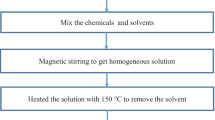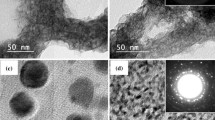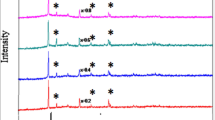Abstract
In this work, Boron-doped Bx:Ni/NiOδ [x(%) = 0.0, 5.0, 10.0 and 15.0] core/shell magnetic nanoparticles were synthesized by the polyol reduction process. The XRD spectra of the samples indicate that the B addition does not cause any change in the cubic structure of Ni. The TEM photographs present that nanoparticle formation and accumulation orientation occurs in various shapes as spherical, octahedral-like and octopus-like accumulation. The average particle sizes of Bx:Ni/NiOδ MNPs for x(%) = 0.0, 5.0, 10.0, 15.0 were found as ~ 90, 12, 46, 5 nm, respectively, from the TEM images. It is observed from the temperature and magnetic field dependence magnetization measurements that magnetization of Ni/NiOδ core/shell MNPs increases with increasing Boron concentration from 5 to 15%. One can be deduced that this increment in the magnetization comes from the resulting of strengthening the Ni-B ferromagnetic interaction. The highest saturation magnetizations under 1 T magnetic field were found as ~ 37 and ~ 30 emu/g at 10 and 300 K, respectively.





Similar content being viewed by others
References
C. Tsang et al., Design, fabrication and testing of spin-valve read heads for high density recording. IEEE Trans. Magn. 30(6), 3801–3806 (1994)
X. Huang, P. Jiang, Core–shell structured high-k polymer nanocomposites for energy storage and dielectric applications. Adv. Mater. 27(3), 546–554 (2015)
Y.Z. Chen et al., Tiny Pd@ Co core–shell nanoparticles confined inside a metal–organic framework for highly efficient catalysis. Small 11(1), 71–76 (2015)
S. Karamipour, M. Sadjadi, N. Farhadyar, Fabrication and spectroscopic studies of folic acid-conjugated Fe3O4@ Au core–shell for targeted drug delivery application. Spectrochim. Acta A 148, 146–155 (2015)
E. Fallahiarezoudar et al., Fabrication (ferrofluid/polyvinyl alcohol) magnetic nanofibers via co-axial electrospinning. J. Dispers. Sci. Technol. 36(1), 28–31 (2015)
V.C. Ozalp et al., Pathogen detection in complex samples by quartz crystal microbalance sensor coupled to aptamer functionalized core–shell type magnetic separation. Anal. Chim. Acta 853, 533–540 (2015)
D. Xiang et al., Nucleic acid aptamer-guided cancer therapeutics and diagnostics: the next generation of cancer medicine. Theranostics 5(1), 23 (2015)
K. Cho et al., Therapeutic nanoparticles for drug delivery in cancer. Clin Cancer Res 14(5), 1310–1316 (2008)
A. Habib et al., Evaluation of iron-cobalt/ferrite core-shell nanoparticles for cancer thermotherapy. J. Appl. Phys. 103(7), 07A307 (2008)
Y. Wang et al., Co-delivery of drugs and DNA from cationic core–shell nanoparticles self-assembled from a biodegradable copolymer. Nat. Mater. 5(10), 791 (2006)
N. Chopra, L. Claypoole, L.G. Bachas, Morphological control of Ni/NiO core/shell nanoparticles and production of hollow NiO nanostructures. J. Nanoparticle Res. 12(8), 2883–2893 (2010)
I.S. Lee et al., Ni/NiO core/shell nanoparticles for selective binding and magnetic separation of histidine-tagged proteins. J. Am. Chem. Soc. 128(33), 10658–10659 (2006)
C.R.H. Bahl et al., The magnetic moment of NiO nanoparticles determined by Mössbauer spectroscopy. J. Phys.: Condens. Matter. 18(17), 4161 (2006)
A. Rostamnejadi, S. Bagheri, Optical, magnetic, and microwave properties of Ni/NiO nanoparticles. Appl. Phys. A 123(4), 233 (2017)
M.A. Khadar, V. Biju, A. Inoue, Effect of finite size on the magnetization behavior of nanostructured nickel oxide. Mater. Res. Bull. 38(8), 1341–1349 (2003)
H. Sato et al., Transparent conducting p-type NiO thin films prepared by magnetron sputtering. Thin Solid Films 236(1–2), 27–31 (1993)
B. Gokul et al., Synthesis of Ni/NiO nanocomposites by hydrothermal-assisted polyol process and their magnetic properties as a function of annealing temperature. Powder Technol. 274, 98–104 (2015)
D. Peddis et al., Exchange bias in CoFe2O4/NiO nanocomposites. Superlattices Microstruct. 46(1–2), 125–129 (2009)
V. Nandwana et al., Size and shape control of monodisperse FePt nanoparticles. J. Phys. Chem. C 111(11), 4185–4189 (2007)
V.F. Puntes, K.M. Krishnan, A.P. Alivisatos, Colloidal nanocrystal shape and size control: the case of cobalt. Science 291(5511), 2115–2117 (2001)
X. He et al., Size dependence of the magnetic properties of Ni nanoparticles prepared by thermal decomposition method. Nanoscale Res. Lett. 8(1), 446 (2013)
A. Jafari et al., Effect of annealing temperature on magnetic phase transition in Fe3O4 nanoparticles. J. Magn. Magn. Mater. 379, 305–312 (2015)
E. Swatsitang et al., Characterization and magnetic properties of cobalt ferrite nanoparticles. J. Alloys Compd. 664, 792–797 (2016)
S. D’Addato et al., Controlled growth of Ni/NiO core–shell nanoparticles: structure, morphology and tuning of magnetic properties. Appl. Surf. Sci. 306, 2–6 (2014)
C.S. Levin et al., Magnetic—plasmonic core–shell nanoparticles. ACS Nano 3(6), 1379–1388 (2009)
O. Pana et al., Structure, morphology and magnetic properties of Fe–Au core-shell nanoparticles. Surf. Sci. 601(18), 4352–4357 (2007)
A. Sattar, H. El-Sayed, I. ALsuqia, Structural and magnetic properties of CoFe2O4/NiFe2O4 core/shell nanocomposite prepared by the hydrothermal method. J. Magn. Magn. Mater. 395, 89–96 (2015)
H. Zeng et al., Tailoring magnetic properties of core/shell nanoparticles. Appl. Phys. Lett. 85(5), 792–794 (2004)
F. Fiévet, R. Brayner, The polyol process, in Nanomaterials: a danger or a promise?. (Springer, London, 2013), pp. 1–25
Z. Libor, Q. Zhang, The synthesis of nickel nanoparticles with controlled morphology and SiO2/Ni core-shell structures. Mater. Chem. Phys. 114(2–3), 902–907 (2009)
H. Zeng et al., Shape-controlled synthesis and shape-induced texture of MnFe2O4 nanoparticles. J. Am. Chem. Soc. 126(37), 11458–11459 (2004)
N.R. Jana, Y. Chen, X. Peng, Size-and shape-controlled magnetic (Cr, Mn, Fe, Co, Ni) oxide nanocrystals via a simple and general approach. Chem. Mater. 16(20), 3931–3935 (2004)
L. Zhang, R. He, H.-C. Gu, Synthesis and kinetic shape and size evolution of magnetite nanoparticles. Mater. Res. Bull. 41(2), 260–267 (2006)
D. Mott et al., Synthesis of size-controlled and shaped copper nanoparticles. Langmuir 23(10), 5740–5745 (2007)
K. Okitsu, K. Sharyo, R. Nishimura, One-pot synthesis of gold nanorods by ultrasonic irradiation: the effect of pH on the shape of the gold nanorods and nanoparticles. Langmuir 25(14), 7786–7790 (2009)
L. Bai et al., Shape-controlled synthesis of Ni particles via polyol reduction. J. Cryst. Growth 311(8), 2474–2479 (2009)
Y. Sui et al., Low temperature synthesis of Cu2O crystals: shape evolution and growth mechanism. Cryst. Growth Des. 10(1), 99–108 (2009)
W. Shen et al., Growth mechanism of octahedral like nickel ferrite crystals prepared by modified hydrothermal method and morphology dependent magnetic performance. Ceram. Int. 44(8), 9809–9815 (2018)
S.H. Masunaga et al., Role of dipolar interactions in a system of Ni nanoparticles studied by magnetic susceptibility measurements. Phys. Rev. B 80(18), 184428 (2009)
J. Vargas et al., Effect of dipolar interaction observed in iron-based nanoparticles. Phys. Rev. B 72(18), 184428 (2005)
J. Dormann, D. Fiorani, E. Tronc, On the models for interparticle interactions in nanoparticle assemblies: comparison with experimental results. J. Magn. Magn. Mater. 202(1), 251–267 (1999)
P. Allia et al., Magnetic hysteresis based on dipolar interactions in granular magnetic systems. Phys. Rev. B 60(17), 12207 (1999)
X.-C. Sun, X.-L. Dong, Magnetic properties and microstructure of carbon encapsulated Ni nanoparticles and pure Ni nanoparticles coated with NiO layer. Mater. Res. Bull. 37(5), 991–1004 (2002)
D. Kechrakos, K. Trohidou, Magnetic properties of dipolar interacting single-domain particles. Phys. Rev. B 58(18), 12169 (1998)
İ Adanur, M. Akyol, A. Ekicibil, Effect of reducing agent and surfactant on the morphology, structural and magnetic properties of Ni magnetic nanoparticles. Philos. Mag. Lett. 98(8), 319–329 (2018)
X. Zhao et al., Exchange-biased NiFe2O4/NiO nanocomposites derived from NiFe-layered double hydroxides as a single precursor. Nano Res. 3(3), 200–210 (2010)
A. El-Gendy et al., The synthesis of carbon coated Fe, Co and Ni nanoparticles and an examination of their magnetic properties. Carbon 47(12), 2821–2828 (2009)
P. Joy, P.A. Kumar, S. Date, The relationship between field-cooled and zero-field-cooled susceptibilities of some ordered magnetic systems. J. Phys. 10(48), 11049 (1998)
P.A. Kumar, P. Joy, S. Date, Comparison of the low Comparison of the low field magnetic behavior of Ln0.7Ca0.12 3MnO3 (Ln= La, Pr). Solid State Commun. 108(2), 67–70 (1998)
T. Torres et al., Validity of the Néel-Arrhenius model for highly anisotropic CoxFe3–xO4 nanoparticles. J. Appl. Phys. 118(18), 183902 (2015)
M. Rajendran et al., Magnetic properties of nanocrystalline CoFe2O4 powders prepared at room temperature: variation with crystallite size. J. Magn. Magn. Mater. 232(1–2), 71–83 (2001)
M. Akyol et al., Effect of boron content on structure and magnetic properties in CoFe2O4 spinel nanocrystals. J. Alloys Compd. 744, 528–534 (2018)
M. Ma et al., Size dependence of specific power absorption of Fe3O4 particles in AC magnetic field. J. Magn. Magn. Mater. 268(1–2), 33–39 (2004)
S. Majetich et al., Magnetic nanoparticles and magnetocrystalline anisotropy. Nanostruct. Mater. 9(1–8), 291–300 (1997)
C. Cannas et al., CoFe2O4 and CoFe2O4/SiO2 core/shell nanoparticles: magnetic and spectroscopic study. Chem. Mater. 22(11), 3353–3361 (2010)
L. Yu et al., Size-controlled Ni nanocrystal growth on peptide nanotubes and their magnetic properties. Adv. Mater. 16(8), 709–712 (2004)
J.-H. Hwang et al., Magnetic properties of graphitically encapsulated nickel nanocrystals. J. Mater. Res. 12(4), 1076–1082 (1997)
Acknowledgements
This work was supported by Çukurova University (Adana/Turkey) under the Project Nos. of FYL-2017-7998 and FDK-2019-11498.
Author information
Authors and Affiliations
Corresponding author
Additional information
Publisher's Note
Springer Nature remains neutral with regard to jurisdictional claims in published maps and institutional affiliations.
Rights and permissions
About this article
Cite this article
Adanur, İ., Akyol, M., Tezcan, F. et al. Evaluation of nanoparticle formation and magnetic properties by boron doping in Ni/NiOδ nanoparticles. J Mater Sci: Mater Electron 31, 14591–14600 (2020). https://doi.org/10.1007/s10854-020-04020-3
Received:
Accepted:
Published:
Issue Date:
DOI: https://doi.org/10.1007/s10854-020-04020-3




